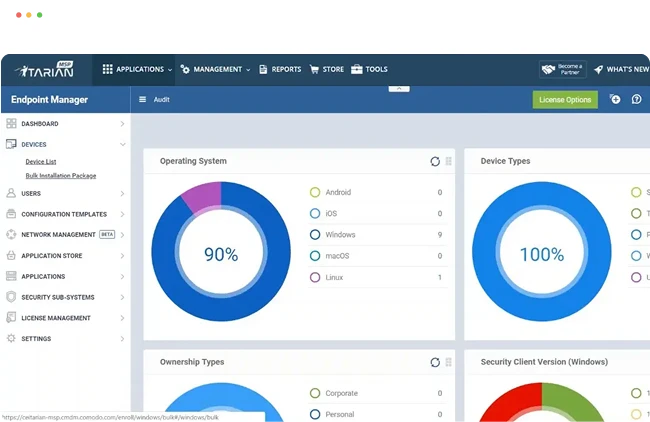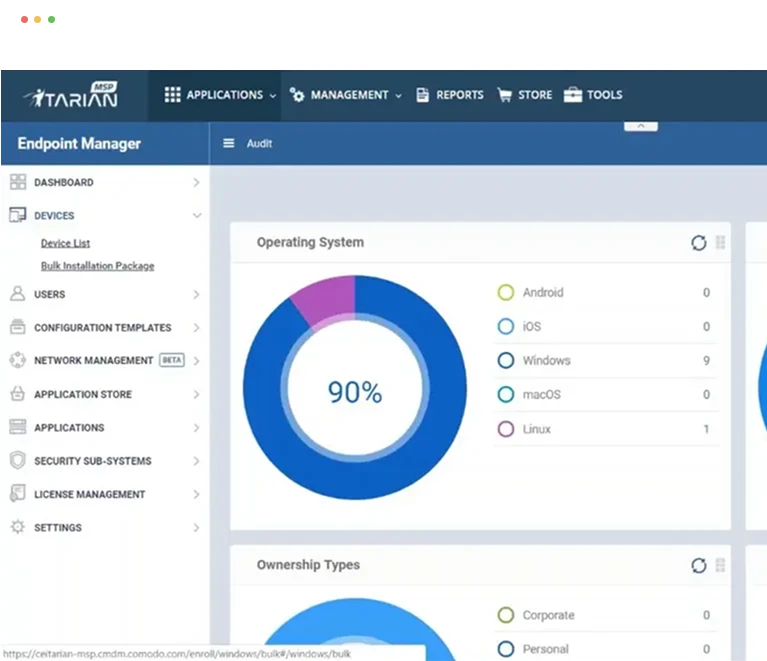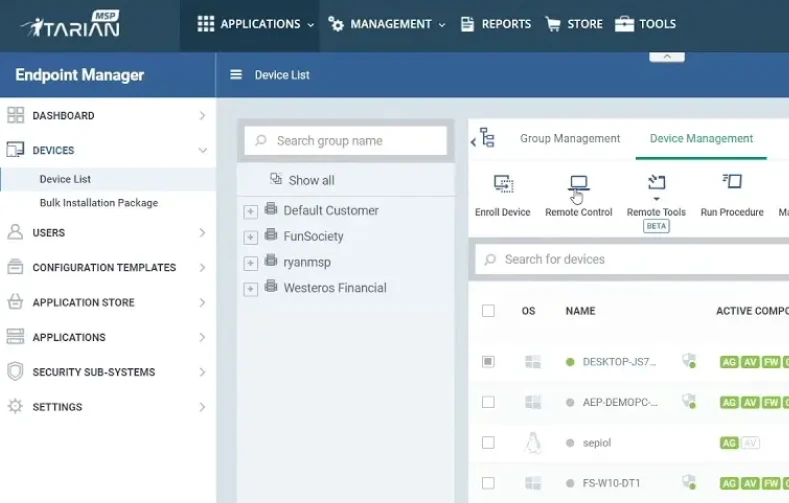Remote Monitoring and Management (RMM)
Take control of your IT environment with ITarian’s Remote Monitoring & Management (RMM)—the all-in-one solution for real-time monitoring, automated patching, remote access, and endpoint security. Designed for MSPs and IT teams, ITarian RMM simplifies device management, reduces downtime, and enhances cybersecurity across your entire network. With AI-powered automation, proactive alerts, and seamless integration, you can ensure peak performance and security for every endpoint.

Monitor, Update, and Protect All Your Client’s Devices with Seamless Scalability
Stay in control of every endpoint with real-time monitoring, automated updates, and robust security—all from a single, intuitive platform. ITarian RMM empowers MSPs and IT teams to proactively track device health, deploy patches, and fortify security without manual intervention. Whether managing a handful of endpoints or scaling across thousands of devices, ITarian’s cloud-based architecture ensures flexibility and efficiency at every level. Enhance uptime, reduce vulnerabilities, and streamline IT operations effortlessly.
Ensure all your systems stay secure and up to date with ITarian’s Automated Patch Management. Effortlessly deploy critical updates across endpoints, minimizing vulnerabilities and reducing manual effort.
Get Started for FreeManage and deploy patches seamlessly across Windows, macOS, and Linux with ITarian’s Multi-OS Support. Keep all your devices secure and compliant, regardless of the operating system.
Get Started for FreeGain complete control over your patching process with ITarian’s Centralized Patch Management Console. Monitor, deploy, and automate updates from a single, user-friendly dashboard.
Get Started for FreeStay informed with ITarian’s Real-Time Patch Status Monitoring. Track patch deployments, detect missing updates, and ensure compliance instantly.
Get Started for FreeQuickly undo problematic updates with ITarian’s Rollback & Remediation. Restore system stability and minimize downtime with seamless patch reversals.
Get Started for FreeEnsure regulatory compliance with ITarian’s Compliance & Reporting. Generate detailed patch reports and audit logs to meet security standards effortlessly.
Get Started for Free
Automate Endpoint Management and Security
Eliminate manual IT tasks and boost efficiency with intelligent automation for endpoint management and security. ITarian RMM enables automated patch deployment, real-time threat detection, and proactive system monitoring, ensuring every device stays updated and protected. With customizable scripts, AI-driven workflows, and hands-free maintenance, IT teams and MSPs can focus on strategic IT initiatives instead of routine troubleshooting. Reduce downtime, enhance security, and scale effortlessly with automated endpoint management.
Get Started for Free
Testimonials
"We are a small managed service provider in the U.K. that focuses on serving our customers with the very best IT experience possible - be that computer repairs, maintenance or security. We are currently taking full advantage of the remote management and monitoring module of ITarian, which enables us to monitor our customers and service them faster. By having access to a proven,service management tool like ITarian, we can grow our business by automating tasks without sacrificing service or performance."
"The business around Aquaflam is built in part around our ability to service our customers remotely and ensure there is never any down time with our service calls, our maintenance, or our upgrades to customers. The ITarian platform is a great opportunity for us as a small business to take full advantage of a free, proven, secure RMM technology that we think will help us to monitor and service our customers better."
“ITarian is giving us better utilization of our internal resources, freeing up time to focus on additional customer challenges and solve them quickly –and, we’re saving money because it is all free. We can now move our break fix customers to a managed services model that will generate new revenue streams for us. We look forward to a very long relationship with ITarian and helping them to continue to make ITarian a success for all."
"Évolur is an early adopter of the ITarian platform. We are very pleased with the flexibility and options that platform gives us, to help service our customers better. We are already starting to leverage the remote monitoring and management capabilities within ITarian MSP, which has been very intuitive and easy to use. We look forward to leveraging more of the platform in the months to come."
Many customers of Marly Computers vof are small to medium sized businesses, who truly appreciate our hands-on and dedicated approach we take to solve their IT challenges. Our technical team is always on the road helping our clients, and the lack of a remote management and monitoring system in place always created a challenge for us. Since taking advantage of ITarian's remote management features and offerings, we started seeing faster response times, quicker remediation and improved management of our customers. We are very happy to be an early adopter of the ITarian managed services platform and look forward to exploring more of its offerings in the months to come."
“The money we are saving on licensing fees and other service costs through the ITarian MSP allows us to hire more people and better compete for business. ITarian MSP is an excellent solution that meets our RMM needs. The fact that there are additional features being added to the platform in the months to come allows us to focus on continued growth while also solidifying the customer relationships we have worked so hard to build."
Why Choose ITarian?
ITarian offers a comprehensive IT management platform that streamlines remote access, patch management, automation, and asset tracking—all from a single, centralized dashboard. With advanced security features, automation capabilities, and real-time analytics, ITarian empowers IT teams to enhance efficiency, reduce risks, and improve overall IT infrastructure management.
